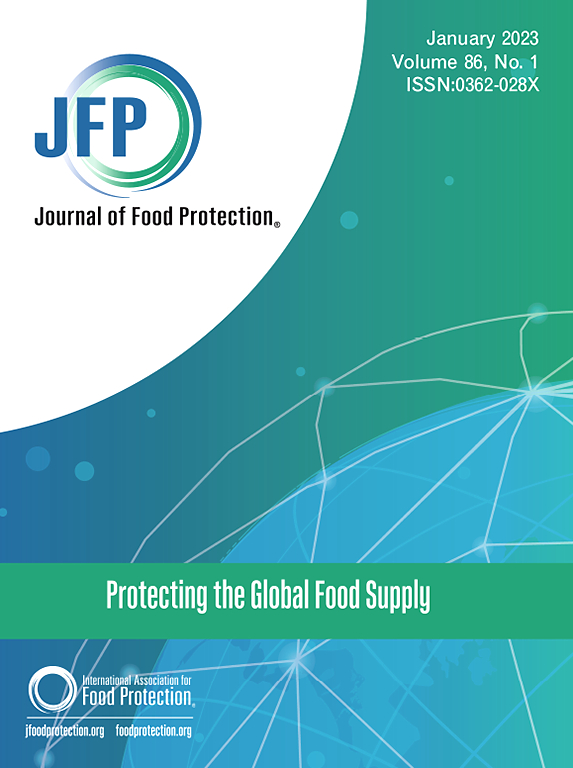Survival of Generic Escherichia coli on In-Field Mature and Immature Gala and Golden Delicious Apples With or Without Overhead Evaporative Cooling Treatment
IF 2.1
4区 农林科学
Q3 BIOTECHNOLOGY & APPLIED MICROBIOLOGY
引用次数: 0
Abstract
The application of overhead evaporative cooling (EC) with untreated surface water is common in Washington State to decrease sunburn on apples. While this practice reduces crop and economic losses, applying untreated surface water to produce introduces potential risks of foodborne pathogen contamination. This study examined EC and the survival of inoculated generic Escherichia coli for two apple varieties over three growing seasons. Factors examined included EC treatment (conventional, untreated), canopy location (high, low), and apple variety (Gala, Golden Delicious). Fruit maturity (mature, immature) was also examined for one year. A rifampicin-resistant generic E. coli cocktail was applied to apples at 7.3 ± 0.4 log CFU/apple, and apples were enumerated for E. coli levels at 0, 2, 10, 18, 34, 42, 58, 82, 106, and 154 h postinoculation. Log-linear, Weibull, and Biphasic models were utilized to characterize the die-off pattern of E. coli. For most treatments, inoculated E. coli decreased by almost or over 6 log CFU/apple over the study duration; however, E. coli remained detectable at low levels on apples at 154 h postinoculation. EC treatment and canopy location did not significantly impact daily linear E. coli die-off rates. Apple variety and maturity demonstrated small but statistically significant impacts on daily linear die-off rates. Nonlinear models (i.e., biphasic and Weibull) best captured E. coli die-off on apples, showing a rapid initial decrease followed by a slower decline over time. Overall, results demonstrate that EC, a useful fruit quality practice, did not impact the survival of inoculated generic E. coli on apple surfaces. The study provides valuable insights for the apple industry regarding E. coli die-off rates on in-field apples, guiding practical decisions to mitigate risk.
田间成熟和未成熟嘎啦苹果和金味苹果经或未经高空蒸发冷却处理后的普通大肠杆菌存活率。
华盛顿州常用未经处理的地表水进行高空蒸发冷却(EC),以减少苹果的日灼。虽然这种做法可以减少作物和经济损失,但将未经处理的地表水用于农产品会带来食源性病原体污染的潜在风险。本研究考察了三个生长季中两种苹果品种的 EC 和接种普通大肠杆菌的存活率。考察因素包括 EC 处理(常规、未处理)、树冠位置(高、低)和苹果品种(嘎啦、金味)。此外,还考察了一年的果实成熟度(成熟、未成熟)。在苹果上施用抗利福平的大肠杆菌鸡尾酒,浓度为 7.3 ± 0.4 log CFU/苹果,并在接种后 0、2、10、18、34、42、58、82、106 和 154 h 对苹果进行大肠杆菌含量计数。利用对数线性模型、Weibull 模型和双相模型来描述大肠杆菌的死亡模式。在大多数处理中,接种的大肠杆菌在研究持续时间内几乎或超过 6 log CFU/苹果,但在接种后 154 小时,苹果上仍能检测到低水平的大肠杆菌。氨基甲酸乙酯处理和树冠位置对大肠杆菌的日线性死亡率没有明显影响。苹果品种和成熟度对每日线性死亡率的影响较小,但在统计学上有显著影响。非线性模型(即双相模型和威布尔模型)最能反映苹果上大肠杆菌的死亡情况,显示出最初的快速下降,随后随着时间的推移下降速度减慢。总之,研究结果表明,作为一种有用的水果质量措施,EC 不会影响接种的普通大肠杆菌在苹果表面的存活。这项研究为苹果产业提供了有关田间苹果大肠杆菌致死率的宝贵见解,为降低风险的实际决策提供了指导。
本文章由计算机程序翻译,如有差异,请以英文原文为准。
求助全文
约1分钟内获得全文
求助全文
来源期刊

Journal of food protection
工程技术-生物工程与应用微生物
CiteScore
4.20
自引率
5.00%
发文量
296
审稿时长
2.5 months
期刊介绍:
The Journal of Food Protection® (JFP) is an international, monthly scientific journal in the English language published by the International Association for Food Protection (IAFP). JFP publishes research and review articles on all aspects of food protection and safety. Major emphases of JFP are placed on studies dealing with:
Tracking, detecting (including traditional, molecular, and real-time), inactivating, and controlling food-related hazards, including microorganisms (including antibiotic resistance), microbial (mycotoxins, seafood toxins) and non-microbial toxins (heavy metals, pesticides, veterinary drug residues, migrants from food packaging, and processing contaminants), allergens and pests (insects, rodents) in human food, pet food and animal feed throughout the food chain;
Microbiological food quality and traditional/novel methods to assay microbiological food quality;
Prevention of food-related hazards and food spoilage through food preservatives and thermal/non-thermal processes, including process validation;
Food fermentations and food-related probiotics;
Safe food handling practices during pre-harvest, harvest, post-harvest, distribution and consumption, including food safety education for retailers, foodservice, and consumers;
Risk assessments for food-related hazards;
Economic impact of food-related hazards, foodborne illness, food loss, food spoilage, and adulterated foods;
Food fraud, food authentication, food defense, and foodborne disease outbreak investigations.
 求助内容:
求助内容: 应助结果提醒方式:
应助结果提醒方式:


